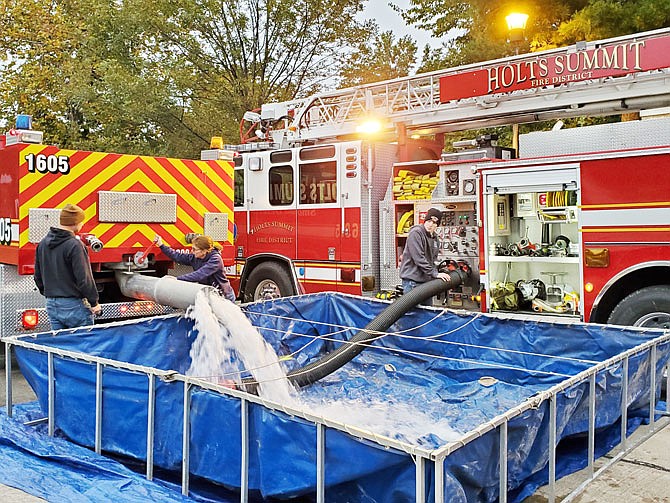Fifteen tanker trucks from multiple fire departments were used in March 2016 to shuttle water to a fire that destroyed three buildings at Fairview Farms horse farm in New Bloomfield.
In January of this year, nine fire departments were involved in bringing water to fight a fire that destroyed the Evergreen Condos in Holts Summit.
After battling these type of fires and knowing many locations in Callaway County don't have access to fire hydrants, many of the fire departments in the county decided to get together to improve water shuttle training.
On Thursday night at the Lake Mykee subdivision, the Holts Summit Fire Protection District hosted crews from the Central Callaway, Southern Boone, South Callaway and Millersburg fire protection districts for this operation. Water was taken from the lake, which was put into the tanker trucks. The trucks then dumped water into portable tanks. At fire scenes, the tankers take the water from the portable tanks to combat a fire.
"Being that most of our response areas along with our neighboring departments are widely rural, water supply is very important," Holts Summit Lt. Clay Hasty said. "We want to bring these departments together to make sure that, come an emergency situation, we are completely ready to perform to save life and property."
Hasty said practices like those Thursday night help members of the departments get to know one another and also get familiar with the different pieces of equipment each department has available.
"It depends on where the fire is at and road conditions, but usually, a round trip for a tanker is 15-20 minutes," Hasty said. "In Holts Summit, we only have three tankers, and that would be nowhere near enough for a large fire, so we have to have mutual aid help. You can easily get 10 tanker trucks wrapped up in a fire."
Hasty said, at minimum in Callaway County, three departments could be involved in fighting a single structure fire. He said Thursday night's exercise was close to the scale of tankers used to fight the fires at the horse farm and the apartments.
"We work pretty good on mutual aid calls on smaller fires, but for a big scale fire, you have to be efficient at it, and we don't have calls that are big scale every year," Hasty said. "We try to have big scale practices as much as we can."
All the departments involved in Thursday's exercise are volunteer departments, and Hasty said sometimes when a call comes in, that can mean there may be just one person per truck to respond.
"We typically try to have at least three people on a truck, but you have to deal with what you've got," he said.

